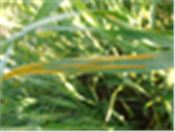|
Stripe Rust Of Wheat Update
DR. CARL A. BRADLEY
PRINCETON, KY.
Stripe rust, caused by the fungus Puccinia striiformis, was fairly prevalent in Kentucky wheat fields in 2016, and will likely make an appearance again in 2017. Generally, the stripe rust fungus doesn’t survive Kentucky winters, but it can move into Kentucky during the growing season from states south of Kentucky. So far this season, stripe rust has been observed in states like Mississippi and Arkansas, which is an indication that the disease is headed northward. A major pathway in which the stripe rust fungus’ spores move northward is the Mississippi River Valley, so once the disease is in states like Mississippi and Arkansas, it is only a matter of time before it arrives in Kentucky.
Fortunately, many wheat varieties are resistant to stripe rust. For resistant varieties, no additional management will be needed. In addition to checking with the seed company about how resistant a specific wheat variety may be, this information may also be obtained by looking at the results of the 2016 University of Kentucky Wheat Variety Performance Trials. If a variety is susceptible to stripe rust, a foliar fungicide application may be needed.
Scouting & Management
Since stripe rust is present in nearby states, it is important to scout for this disease. Beginning symptoms appear as yellow streaks on leaves. Orange pustules will then appear in a “striped” pattern where the yellow streaks first occurred (Figure 1). Yield loss is related to how early stripe rust appears. In many years, stripe rust may not occur until after heading. In those cases, a fungicide specifically for stripe rust control will likely not be needed. If stripe rust appears prior to heading on a susceptible variety, then yield loss may occur. A fungicide applied at early flowering (Feekes growth stage 10.5.1) for Fusarium head blight control (such as Prosaro or Caramba) will provide protection against stripe rust; however, depending on when stripe rust first appears, the susceptibility of the variety, and the rate of disease progression, an earlier fungicide application may be needed. Most fungicide products available for wheat will provide a satisfactory level of control of stripe rust as long as they are applied before stripe rust gets to damaging levels. An application of a foliar fungicide when flag leaves have emerged, will help protect the most important leaf on a wheat plant and protect against yield losses. ∆
DR. CARL A. BRADLEY: Extension Plant Pathologist, University of Kentucky

Figure 1. Stripe rust pustules on a wheat leaf.
Photo: Carl Bradley, UK
|
|